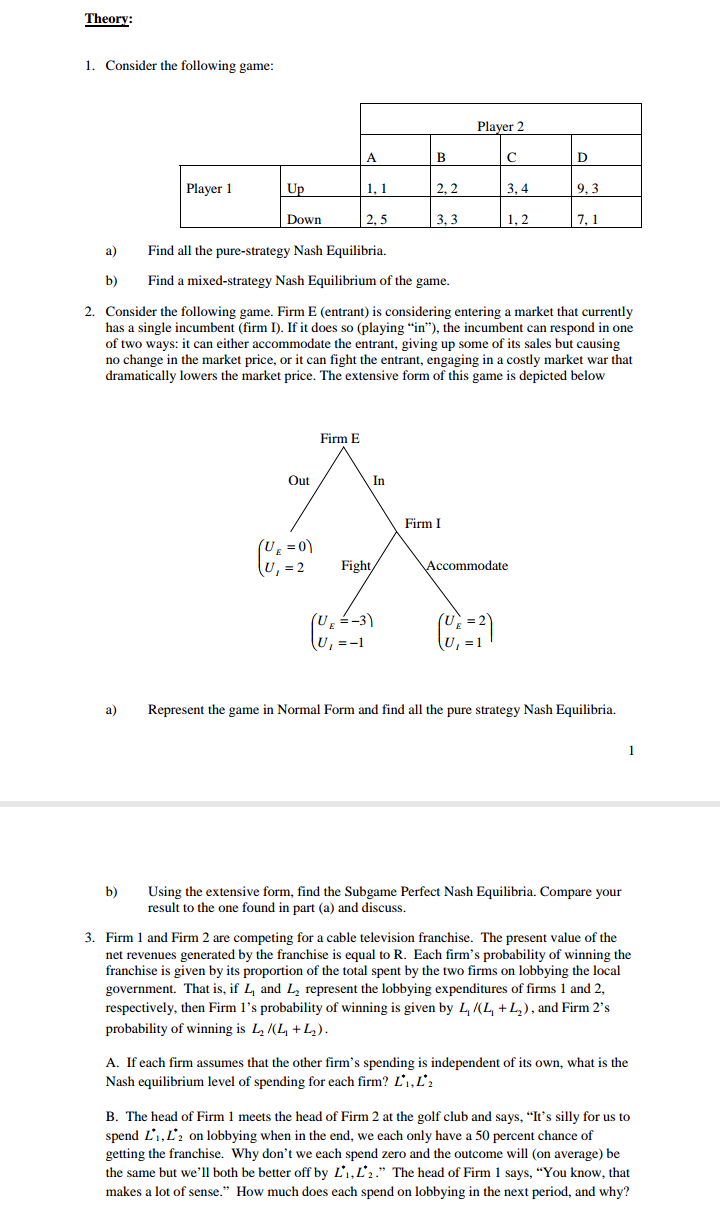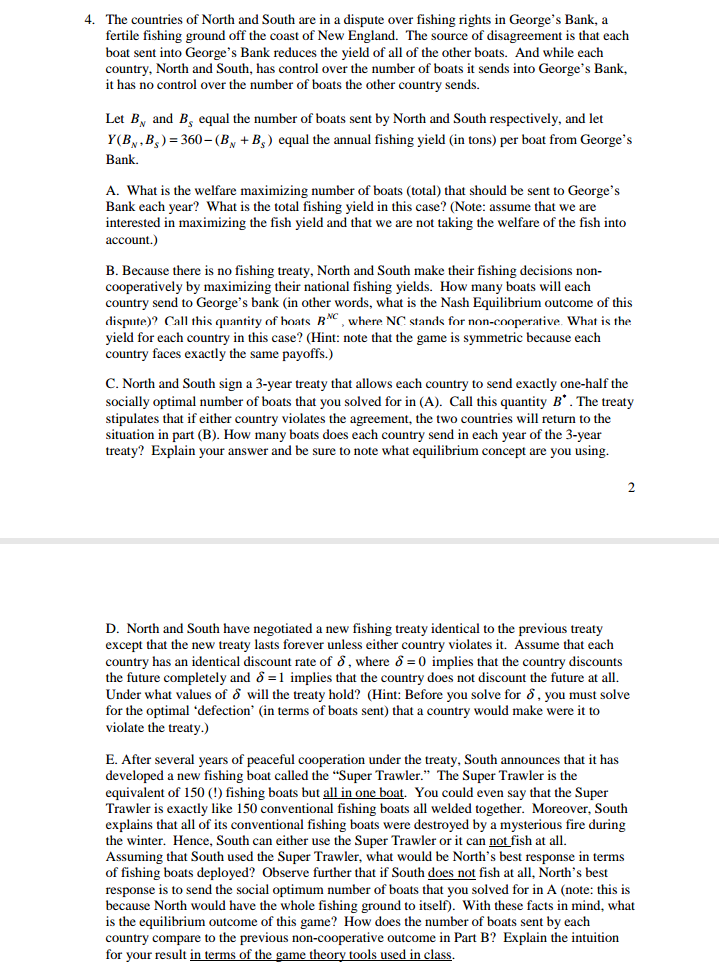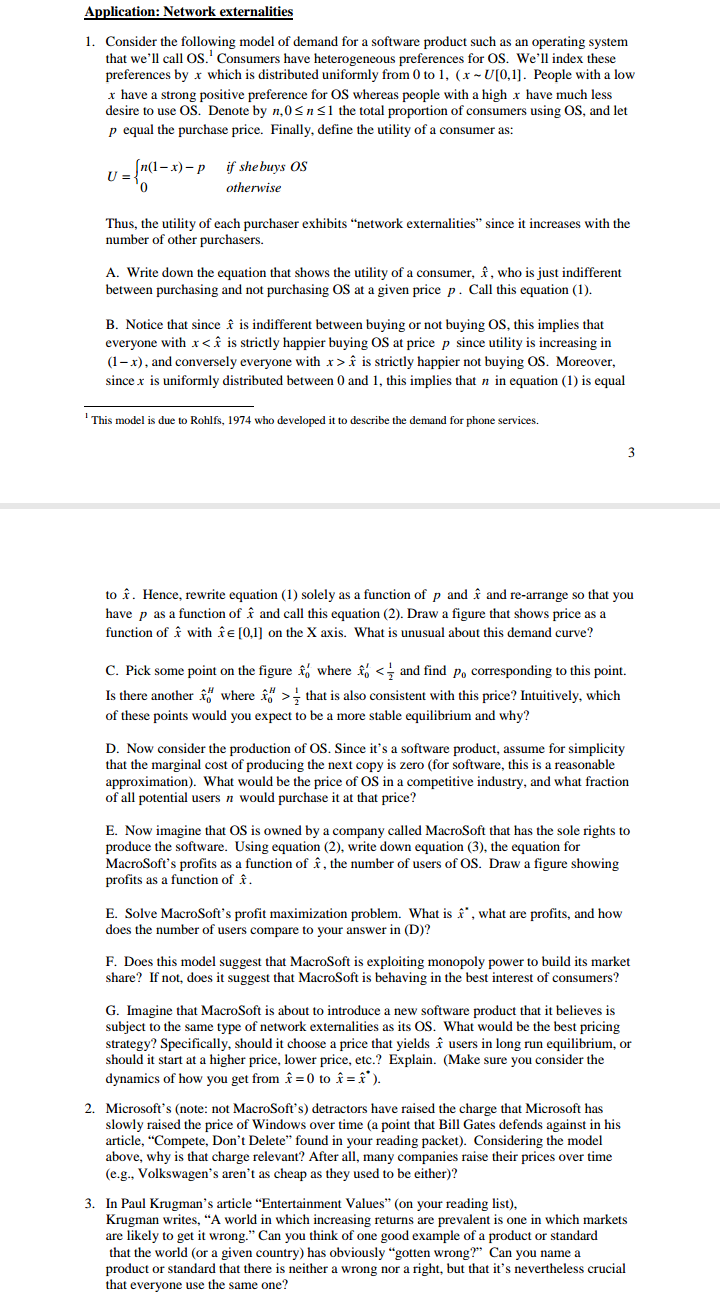


Ensure you show alll the strategies of the game in all parts of the question
Theog: 1. Consider the following game: a} Find all the pure-snategy Nash Equilibria. b] Find a mixed-strategy Nash Equilibrium of the game. Consider the following game. Firm E (entrant) is considering entering a market that currently has a single incumbent (rm I). [fit does so (playing \"in"}, the incumbent can respond in one of two ways: it can either accommodate the entrant, giving up some of its sales but causing no change in the market price, or it can ght the entrant, engaging in a costly market war that dramatically lowers the market price. The extensive form of this game is depicted below a} Represent the game in Normal Form and nd all the pure strategy Nash Equilibria. b) Using the extensive forml nd the Subgarne Perfect Nash Equilibria. Compare your result to the one found in part (a) and discuss. Firm 1 and Firm 2 are competing for a cable television franchise. The present value of the net revenues generated by the franchise is equal to R. Each rm's probability of winning the franchise is given by its proportion of the total spent by the two rms on lobbying the local government. That is, if L1 and L2 representthe lobbying expenditures afrms l and 2, respectively. then Firm 1's probability of winning is given by 1.1 111.1 + L2) , and Firm 2's pmbability of winning is I.z H11 + L2) . A. If each rm assumes that the other rm's spending is independent of its can what is the Nash equilibrium level of spending for each rm? LLB; B. The head of Firm 1 meets the head of Firm 2 at the golf club and says, I'It's silly for us to spend I... , L": on lobbying when in the end, we each only have a 5i] percent chance of getting the franchise. Why don't we each spend zero and the outcome will {on average) be the same but we'll both be better ofl'by 1.13; ." The head ofFirm 1 says, \"You know. that makes a lot of sense.\" How much does each spend on lobbying in the next period, and why? 4. The countries of North and South are in a dispute over fishing rights in George's Bank, a fertile fishing ground off the coast of New England. The source of disagreement is that each boat sent into George's Bank reduces the yield of all of the other boats. And while each country, North and South, has control over the number of boats it sends into George's Bank, it has no control over the number of boats the other country sends. Let By and By equal the number of boats sent by North and South respectively, and let Y(By, B, ) = 360-(By + By ) equal the annual fishing yield (in tons) per boat from George's Bank. A. What is the welfare maximizing number of boats (total) that should be sent to George's Bank each year? What is the total fishing yield in this case? (Note: assume that we are interested in maximizing the fish yield and that we are not taking the welfare of the fish into account.) B. Because there is no fishing treaty, North and South make their fishing decisions non- cooperatively by maximizing their national fishing yields. How many boats will each country send to George's bank (in other words, what is the Nash Equilibrium outcome of this dispute)? Call this quantity of boats R" , where NC stands for non-cooperative. What is the yield for each country in this case? (Hint: note that the game is symmetric because each country faces exactly the same payoffs.) C. North and South sign a 3-year treaty that allows each country to send exactly one-half the socially optimal number of boats that you solved for in (A). Call this quantity B" . The treaty stipulates that if either country violates the agreement, the two countries will return to the situation in part (B). How many boats does each country send in each year of the 3-year treaty? Explain your answer and be sure to note what equilibrium concept are you using. 2 D. North and South have negotiated a new fishing treaty identical to the previous treaty except that the new treaty lasts forever unless either country violates it. Assume that each country has an identical discount rate of o , where o =0 implies that the country discounts the future completely and o =1 implies that the country does not discount the future at all. Under what values of o will the treaty hold? (Hint: Before you solve for o , you must solve for the optimal 'defection' (in terms of boats sent) that a country would make were it to violate the treaty.) E. After several years of peaceful cooperation under the treaty, South announces that it has developed a new fishing boat called the "Super Trawler." The Super Trawler is the equivalent of 150 (!) fishing boats but all in one boat. You could even say that the Super Trawler is exactly like 150 conventional fishing boats all welded together. Moreover, South explains that all of its conventional fishing boats were destroyed by a mysterious fire during the winter. Hence, South can either use the Super Trawler or it can not fish at all. Assuming that South used the Super Trawler, what would be North's best response in terms of fishing boats deployed? Observe further that if South does not fish at all, North's best response is to send the social optimum number of boats that you solved for in A (note: this is because North would have the whole fishing ground to itself). With these facts in mind, what is the equilibrium outcome of this game? How does the number of boats sent by each country compare to the previous non-cooperative outcome in Part B? Explain the intuition for your result in terms of the game theory tools used in class.Application: Network externalities 1. Consider the following model of demand for a software product such as an operating system that we'll call OS." Consumers have heterogeneous preferences for OS. We'll index these preferences by x which is distributed uniformly from 0 to 1, (x ~ U[0,1]. People with a low x have a strong positive preference for OS whereas people with a high x have much less desire to use OS. Denote by n, 0 n 1 the total proportion of consumers using OS, and let p equal the purchase price. Finally, define the utility of a consumer as: U =(1-x)-p if shebuys OS otherwise Thus, the utility of each purchaser exhibits "network externalities" since it increases with the number of other purchasers. A. Write down the equation that shows the utility of a consumer, & , who is just indifferent between purchasing and not purchasing OS at a given price p. Call this equation (1). B. Notice that since & is indifferent between buying or not buying OS, this implies that everyone with x x is strictly happier not buying OS. Moreover, since x is uniformly distributed between 0 and 1, this implies that n in equation (1) is equal This model is due to Rohlfs, 1974 who developed it to describe the demand for phone services. 3 to x. Hence, rewrite equation (1) solely as a function of p and & and re-arrange so that you have p as a function of & and call this equation (2). Draw a figure that shows price as a function of & with re [0,1] on the X axis. What is unusual about this demand curve? C. Pick some point on the figure s, where i, , that is also consistent with this price? Intuitively, which of these points would you expect to be a more stable equilibrium and why? D. Now consider the production of OS. Since it's a software product, assume for simplicity that the marginal cost of producing the next copy is zero (for software, this is a reasonable approximation). What would be the price of OS in a competitive industry, and what fraction of all potential users n would purchase it at that price? E. Now imagine that OS is owned by a company called MacroSoft that has the sole rights to produce the software. Using equation (2), write down equation (3), the equation for MacroSoft's profits as a function of &, the number of users of OS. Draw a figure showing profits as a function of &. E. Solve MacroSoft's profit maximization problem. What is & , what are profits, and how does the number of users compare to your answer in (D)? F. Does this model suggest that MacroSoft is exploiting monopoly power to build its market share? If not, does it suggest that MacroSoft is behaving in the best interest of consumers? G. Imagine that MacroSoft is about to introduce a new software product that it believes is subject to the same type of network externalities as its OS. What would be the best pricing strategy? Specifically, should it choose a price that yields x users in long run equilibrium, or should it start at a higher price, lower price, etc.? Explain. (Make sure you consider the dynamics of how you get from x = 0 to * = i ). 2. Microsoft's (note: not MacroSoft's) detractors have raised the charge that Microsoft has slowly raised the price of Windows over time (a point that Bill Gates defends against in his article, "Compete, Don't Delete" found in your reading packet). Considering the model above, why is that charge relevant? After all, many companies raise their prices over time (e.g., Volkswagen's aren't as cheap as they used to be either)? 3. In Paul Krugman's article "Entertainment Values" (on your reading list), Krugman writes, "A world in which increasing returns are prevalent is one in which markets are likely to get it wrong." Can you think of one good example of a product or standard that the world (or a given country) has obviously "gotten wrong?" Can you name a product or standard that there is neither a wrong nor a right, but that it's nevertheless crucial that everyone use the same one












